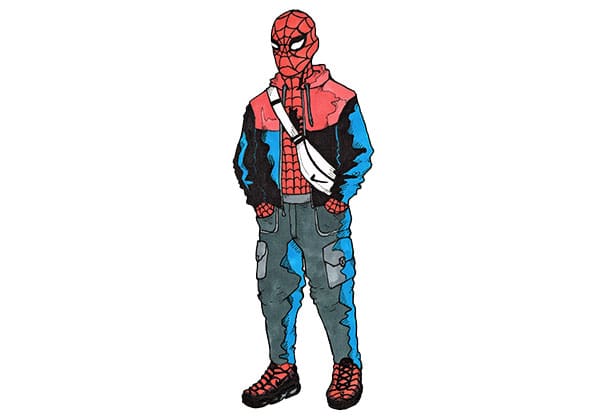In Sam Raimi’s Spider-Man 2, Aunt May, played by Rosemary Harris, tells a sorrowful Peter Parker, played by Tobey Magure, that “kids like Henry need a hero. Courageous, self-sacrificing people. Setting examples for all of us.” Like young Henry, I found that the hero in Spider-Man — a bullied teenager, who after being bit by a radioactive spider, developing super powers and losing his Uncle Ben, aims to live up to the mantra of “with great power comes great great responsibility.”
Beyond the heroism and courage, the freedom, the subversive transhumanism, and the jocularity of Spider-Man make the iconic character a staple in every child’s imagination. I would also go so far as to argue that his Oedipus guilt, crisis of consciousness and marked inferiority complex that defines the wall-crawling web-slinger is worthy of rigorous psychological study, for the academically and critically inclined. Perhaps this sentiment would challenge the widely accepted notion that Peter Parker’s problems are our own — a situation which attracts remarkable empathy, and as a result, commercial success. However, what makes Spider-Man even more endearing than a relatable (should you ignore the deeply troubled nature of his psyche) and profitable comic book hero is just how powerful and flexible of a symbol the character can be.
I once made a point of celebrating how liberatory the comic book medium was by suggesting there was no logical link that could be made between my childhood heroes and my Western Sydney upbringing (with the shadow intent of introducing Edward Said into the Honi archives). However, considering a Covid-19 pandemic that has ravaged the health and political identity of LGAs in Western Sydney, the symbol that is Spider-Man is enlivened, and as a result, comic books become not just liberatory but illuminating.
In the early 1960s, the Cold War had directly and indirectly permeated throughout the medium. As a young person, Spider-Man was the perfect vessel through which one could discern and analyse the radical polity of a young generation rebelling against authority and power. As the cultural historian, Bradford W. Wright observes, in light of militant student activism at Parker’s Empire State University, Parker is engrossed in a tension between his solidarity with the noble intent of students and his obligations to maintain order as Spider-Man. The protests at the fictional Empire State appeared to be mirrored after militant student demonstrations at Columbia University. It is an interesting paradox: the anarchic, rebellious outlaw maintains order. Is this not a fitting exploration of the tensions that are coming to define the environment in Western Sydney? I dare say, a Western Sydney consciousness cannot help but feel torn between the legitimate grievances of poorer suburbs that inspire militant protests against government policy and the need to maintain order to quell the spread of the delta variant. Much like Spider-Man, Western Sydney finds itself caught within a rift between militant (albeit incredibly flawed and misguided) manifestations of economic and social grievances and the need for stringent government enforcement and policing. The deadly Covid-19 pandemic asserts on the consciousness of communities an obligation to quell disorder. But at the same time, like the web-slinger, there is sympathy, if not empathy, that is hard to ignore for a community shattered by the pandemic and all its ramifications. Add in a media environment as critical of Western Sydney as J Jonah Jameson is of Spider-Man, and you have yourself a congruent state of affairs. It would not surprise me to see Covid-19 take on a Cold War-like influence on the comic book medium in the years to come.
A post-Covid 19 world would inevitably have to grapple with the financial carnage that has decimated a pre-Covid way of life. Spider-Man is also, for lack of a better term, a poor superhero. The economically disadvantaged LGAs share that particular trait. But the LGAs also share Spider-Man’s resilience, altruism, and heroism. Consider Fairfield, a Western Sydney Suburb with one of the highest rates of volunteering efforts in the state. Western Sydney finds itself represented by a class-conscious hero, a class-consciousness celebrated by Stan Lee and Steve Ditko and ultimately neglected by the Marvel Cinematic Universe’s (MCU) portrayal of Spider-Man (the influence of Tony Stark and silicon-like technological domination negates the ‘neighbourhood-ness’ of our Friendly Neighbourhood Spider-Man).
Nonetheless, the return of Alfred Molina and Willem Dafoe in Spider-Man: No Way Home (2021) should be welcomed as bringing about an appreciation of just how ‘Transhuman’ Spider-Man is. Not only could one discern the theories of Aristotle, Aquinas, Kant, Nietzsche, Rand and McIntyre, and perhaps even apply the web-slinger as an example in academic institutions, but Spider-Man speaks to a consciousness of not only a generation but a specific community ravaged by peculiarly specific circumstances. The masked wall-crawler illuminates more than the fantasies that dominate one’s imagination. Miles Morales in Spider-Man: Into the Spider-Verse opines that “You can wear the mask.” Well, Western Sydney wears the mask – and I mean that in all its interpretations, whether it be iconically webbed or medicinal.





